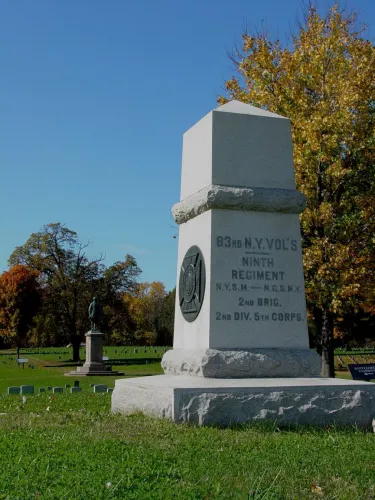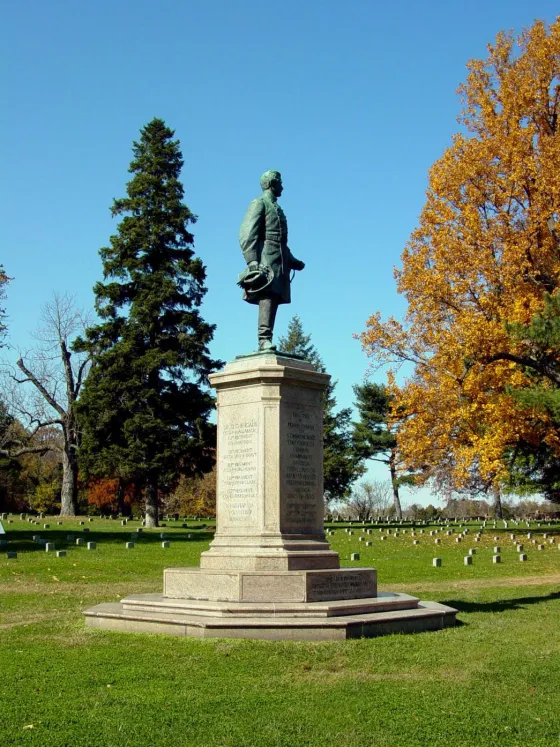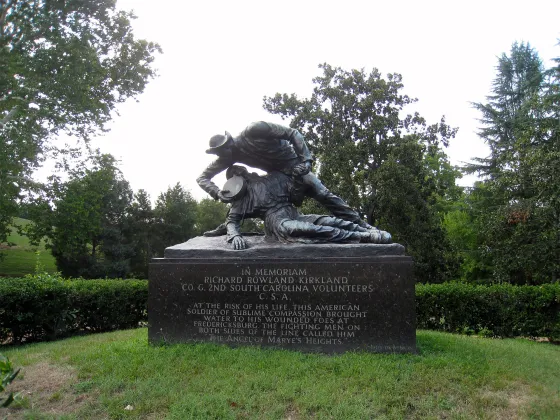Tributes Etched in Stone

Monuments are an important part of any battlefield landscape. They not only remind us of important events, but they show us where those events happened. They are a tangible medium through which we honor the dead and acknowledge their sacrifice. They are tributes etched in stone. Since the 1860s, United States citizens have erected more than 4,000 monuments, markers, and tablets commemorating the Civil War and the men who fought in it.[i] More than 70 of those memorials can be found at Fredericksburg, Chancellorsville, Wilderness, and Spotsylvania Court House, battlefields now encompassed by Fredericksburg and Spotsylvania County National Military Park (FRSP).[ii] Although they represent but a small fraction of the Civil War battlefield monuments raised throughout the nation, the patterns that emerge from a study of the Fredericksburg-area memorials regarding their sponsorship, chronology, and topics largely reflect those in the country as a whole.
The earliest monuments in the Fredericksburg area — those erected in the 19th century — primarily honor individuals killed in action. Some were quite simple. Around 1876, or perhaps a bit later, Maj. James Horace Lacy; his brother, the Rev. Beverly Tucker Lacy; and Horace’s son-in-law Capt. James Power Smith placed an uncut quartz boulder at the site of “Stonewall” Jackson’s fatal wounding at Chancellorsville. Tucker Lacy and Smith had a personal connection with the general, both having served on his staff — Smith as aide-de-camp and Lacy as corps chaplain. They transported the boulder from the nearby Luckett farm, where it had recently been unearthed by work crews widening the Orange Plank Road, and set it on end at the approximate site of Jackson’s demise, where it remains to this day.[iii]
A decade or so later, a small number of Spotsylvania County residents erected a similar rock at the edge of the Widow Tapp Field on the Wilderness Battlefield to commemorate the famous “Lee-to-the-rear incident” in which Confederate Gen. Robert E. Lee attempted to lead the Texas Brigade in a desperate counterattack against the Union army. Horace Lacy may have been involved in this effort too, as the boulder was placed on his property. Over time, the quartz monolith fell over and settled comfortably into the ground, where it remains to this day, all but forgotten by motorists speeding past it just a few feet away along the Orange Plank Road.[iv]
Not all monuments were so small and simple. During this early period, admirers erected finely chiseled granite memorials honoring Jackson, Generals John Sedgwick and Thomas Cobb, and Colonel Josef Anton Moesch, all of whom were killed in area battles. Family members erected Cobb’s monument without fanfare in 1888, but the other three memorials were group efforts and received a great deal of publicity. Veterans of the VI Corps put up the Sedgwick Memorial, former members of the 83rd New York Volunteers (9th New York State Militia) sponsored Moesch’s monument, and a local group that called itself the “Chancellorsville Stonewall Monument Association” spearheaded fundraising efforts for the Jackson memorial.[v] Elaborate dedication ceremonies attended the completion of each. In the case of the Jackson Monument, a reporter noted that as many as 5,000 people turned out in their Sunday best “all bent on pleasure and sight seeing,” some purchasing food at booths while others, exercising greater thrift, bought their own picnic baskets. Some brought more than food. “John Barleycorn knocked down a number of indiscreet visitors at Chancellorsville,” wrote editor Rufus Merchant of the Fredericksburg Star. “They lay about in the woods like dead soldiers... but so complete was their overthrow that they were rendered oblivious of the occasion, and wholly harmless.” Among the speakers that day was Virginia Governor Fitzhugh Lee, who as a cavalry commander screening the Confederate army, had made possible the success of Jackson’s flank attack in the battle.[vi]

The early 20th century ushered in the golden age of Civil War monuments. By then, many of the veterans in the North had organized regimental associations to strengthen the aging bonds of camaraderie and to discuss issues of common interest to members of their unit. Among the issues was the construction of monuments. In the brief interval between the Spanish-American War and World War I, Union veterans placed a dozen new monuments on the Fredericksburg-area battlefields. With one exception — a monument to General Alexander Hays, who died in the Battle of the Wilderness — each of the memorials paid tribute to the unit in which the soldiers served, be it a division, brigade, or regiment.[vii] The veterans had fought, bled, and died for their country. They were proud of their service, and they wanted future generations of Americans to remember them.
By 1900, many Union veterans held seats in the state legislatures, and they used their political influence to secure state funding for some of their projects. Six of the 12 Union monuments created at the turn of the century were funded in whole or in part with state money. These include some of FRSP’s largest and most skillfully crafted memorials, including one honoring General Andrew Humphreys’s division, which the State of Pennsylvania funded to the tune of $23,500. At the top of the monument is a bronze statue of Humphreys, created by noted sculptor Herbert Adams. Since its construction in 1908, the monument has been the centerpiece of Fredericksburg National Cemetery.[viii]
Not content with simply funding the monument, the Pennsylvania State Legislature voted to subsidize the transportation of any veteran of the division who wished to attend the dedication. Hundreds of former soldiers leapt at the offer, many bringing with them friends and family members. Politicians too attended, including Governor Edwin S. Stuart of Pennsylvania and Governor Claude Swanson of Virginia. Major Alexander K. McClure, a former editor of the Philadelphia Times newspaper, delivered the day’s keynote address. He chose brotherhood and reunion as his themes. He compared the attack of Humphreys’s division at Fredericksburg with that of George Pickett’s Confederate division at Gettysburg and predicted that at some point in the future monuments to the Confederacy, and General Lee in particular, would adorn Seminary Ridge, a practice prohibited at the time. That no Confederate monuments stood at Gettysburg at that time, he said, was the fault of petty politicians, not the Union veterans, who had long since put old animosities behind them. Referring to the Humphreys Monument and others like it, he declared, “They no longer stand as monuments for triumph for either the Blue or the Gray, but are accepted by every veteran of the North and South as monuments to the heroism of our American soldiery.”[ix]

Although FRSP encompasses four major battlefields, just 17 monuments were erected to Union soldiers or units there prior to the 1961 Civil War centennial. By contrast, Antietam National Battlefield, which commemorates just one battle, had 68 Union monuments by that time, and Gettysburg National Military Park — another one-battle park — had hundreds. Why the difference? Part of it had to do with geography. Gettysburg and Antietam are north of the Potomac River in areas that had been largely loyal to the Union. Northern monuments placed there were easier for Union veterans to visit and less likely to be vandalized. Another significant point is that Gettysburg and Antietam were Union victories. The four battles fought near Fredericksburg, by contrast, were defeats or, at best, tactical draws. Few veterans wanted their unit to be associated with defeat.
If the number of Union monuments at Fredericksburg prior to World War I was small, the number of Confederate monuments was smaller still. The South suffered economic hardship following the war, and its veterans did not form regimental associations. As we have seen, the first Confederate monuments erected near Fredericksburg were boulders put up by local individuals — efforts requiring a bit of labor but nothing in the way of money. On rare occasions when Southerners raised money for a substantial memorial, such as the Jackson Memorial or the soldier monuments in the Fredericksburg and Spotsylvania Confederate cemeteries, it required an organized fund-raising effort that sometimes canvassed the entire South. As a result, there were just seven Confederate monuments erected prior to 1919, three of them large structures funded by men and women throughout the South, two boulders put up by local individuals, and two small monuments to fallen officers erected by members of their family.[x] To this number must be added ten knee-high granite markers erected in 1903 by Thomas F. Ryan, a philanthropist who made his fortune in tobacco, insurance, and public transit, and who later funded four murals for the Confederate Memorial Institute in Richmond, collectively called the Four Seasons of the Confederacy. The small monuments mark sites near Fredericksburg associated with key Confederate figures, primarily Robert E. Lee and “Stonewall” Jackson. Jackson’s former aide, James Power Smith, helped select and place the markers, which cost their sponsor a total of 250 dollars. Ryan’s markers constitute more than half of the Confederate memorials erected in the Fredericksburg area prior to World War I.[xi]
Southern representation on the battlefields received a major boost beginning in 1917 when the United Daughters of the Confederacy sponsored 10 monuments over a period of just 10 years. Formed in 1894, the purpose of the UDC was to honor the memory of Confederate soldiers, most notably through the building of monuments in the South.[xii] At Fredericksburg, the organization sponsored the creation of five battlefield memorials (one at each of the four major battlegrounds plus Salem Church), small markers identifying the sites of the Martha Stephens house and the upper and middle pontoon sites, a monument at Spotsylvania Confederate Cemetery, and a small tablet in front of Fredericksburg Presbyterian Church, marking the intersection where “Stonewall” Jackson purportedly planned the Battle of Fredericksburg. Despite the partisan nature of the organization, contemporary commentators at the time of installation noted that the UDC’s monuments express no rancor or racist sentiment. Rather, they pay tribute to the patriotism, heroism, and devotion to duty exhibited by both Northern and Southern soldiers.[xiii]
In the years leading up to World War II, individuals and a hodgepodge of organizations placed monuments in and around the park. Most of the monuments commemorated not individuals or units, but rather places, and many involved historian and preservationist Edward T. Stuart. Stuart himself erected three stones on Spotsylvania Battlefield, marking the sites of the East Angle, the West Angle, and the 22-inch oak tree that was felled by rifle fire during the Bloody Angle fighting. Stuart donated 32 acres of ground on the battlefield to the Military Order of the Loyal Legion of the United States (MOLLUS), which then added 130 acres of its own and presented the entire parcel to the National Park Service. In 1940, MOLLUS put up a monument at the site of the Landrum house touting its donation. However, it failed to mention Stuart’s contribution to the effort. When he died later that year, friends and family members corrected that omission, erecting a monument honoring Stuart in the woods just north of the Bloody Angle. Hidden among the trees, it is perhaps the least visited monument in the park.[xiv]
America’s entry into the World War II temporarily brought an end to monument construction in the park. That conflict and the subsequent Cold War left Americans weary of war, especially the Civil War which, to many, now seemed distant and irrelevant. Only with the advent of the Centennial did American interest in the Civil War revive and with it a call for new monuments. The Texas Civil War Centennial Commission led the way, erecting more than a dozen pink granite memorials on battlefields throughout the country, including one in the Wilderness that recognized the bravery of the Texas Brigade in its famous charge across the Tapp Field on May 6, 1864, in which 70 percent of its troops fell to Union rifle fire. South Carolina and Virginia likewise sponsored a monument at this time, commissioning world-renowned sculptor Felix DeWeldon to craft a memorial to Sergeant Richard Kirkland of the 2nd South Carolina Volunteers, who had voluntarily risked his life carrying water to wounded Union soldiers at the Battle of Fredericksburg. For his heroic actions, Kirkland was later dubbed “The Angel of Marye’s Heights.” He died just nine months later at the Battle of Chickamauga. He was just 20 years old.[xv]

Interest in the Civil War subsided after the Centennial, as did interest in erecting new monuments. Indeed, just one memorial was put up in the dozen years following the Centennial: a modest stone marking the location of Captain William Parker’s Virginia battery during the Second Battle of Fredericksburg. The dearth of monument initiatives may have had something to do with a new NPS management policy that called on park superintendents to “discourage and curtail the use and proliferation of commemorative works” except in cases when they were specifically authorized by Congress.[xvi] By the latter half of the 20th century, many people viewed monuments as no longer enhancing historic landscapes but simply cluttering them. The fact that many of the new monuments lacked artistic merit, resembling headstones rather than works of fine sculpture, undoubtedly strengthened this opinion.
Despite the strictures on new memorials, more than a dozen new Civil War monuments have been created in the Fredericksburg area since 1989, seven of them on NPS land. Reenactment groups sponsored five of the new monuments, and developers contributed three more. Not surprisingly, the memorials sponsored by reenactment groups honor the units they portray. Monuments funded by developers, by comparison, mark sites affected by the development and were erected as “mitigation” for the damaging effects their projects caused to the historic landscape. Examples of this include the monuments to Harland’s Brigade and Redoubt No. 3 in Stafford County and the McGee House marker in Spotsylvania.[xvii]
The desire to raise monuments on Civil War battlefields shows no signs of ending. That is a good thing, for they call to mind the great issues of our past and highlight the struggles and sacrifices that shaped our nation. It is when we forget those lessons and begin to take our liberties for granted that we stand in peril of losing them.
[i] Phillip W. Magness, “What the Data Say About Civil War Monuments,” American Institute for Economic Research. https://www.aier.org/article/what-the-data-say-about-civil-war-monument….
[ii] A list of monuments in and around the park appears in Donald C. Pfanz, “History Through Eyes of Stone: A Survey of Civil War Monuments Near Fredericksburg, Virginia,” 2006, pp. 285-87, Fredericksburg and Spotsylvania County National Military Park (hereafter cited FRSP).
[iii] James P. Smith, “Notes of the Rev. James Power Smith, D.D.,” FRSP; Fredericksburg Free Lance, 23 Oct. 1885 and 12 Feb. 1886; Fredericksburg Free Lance-Star, 21 May 1884 and 16 May 1893.
[iv] Richmond Times, 22 Sept. 1891; Fredericksburg Free Lance, 15 Jan. 1892.
[v] Fredericksburg Star, 22 Dec. 1888; Joseph O. Kerbey, On the War Path: A Journey Over the Historic Grounds of the Late Civil War (Chicago: Donohue, Henneberry & Col, 1890), p. 162; G. W. Holmes, “Where a Hero Fell,” Milwaukee Sunday Telegraph, 5 June 1887; Dedication of the Sedgwick Monument (Philadelphia, n.d.); Fredericksburg Free Lance, 27 Sept. 1890.
[vi] Fredericksburg Daily Star, 19, 23, and 26 Feb. 1887 and 16 June 1888; Fredericksburg Free Lance, 15 June 1888.
[vii] Fredericksburg Daily Star, 3 June 1905; George T. Fleming, ed., Life and Letters of Alexander Hays (Pittsburgh, 1919), pp. 646-51; Pfanz, “History Through Eyes of Stone,” passim.
[ix] Acts of Pennsylvania Legislature, Session of 1907, Act 359 (Approved June 13, 1907) and Session of 1909, Act 508 (Approved May 13, 1909); Dedication of Monument (Philadelphia, 1908); Fredericksburg Daily Star, 11 Nov. 1908; “Many Prominent Persons Present, Southern Historical Society Papers, 36:174-79.
[x] Pfanz, “History Through Eyes of Stone,” pp. 285-87.
[xi] Thomas Fortune Ryan, https://en.wikipedia.org/wiki/Thomas_Fortune_Ryan; Fredericksburg Daily Star, 10 and 24 Aug. 1903; James P. Smith, “Spotsylvania Markers,” Southern Historical Society Papers, 39:100-101; “Spotsylvania Battlefield Field Markers,” Southern Historical Society Papers, 41:145-46.
[xii] United Daughters of the Confederacy, https://en.wikipedia.org/wiki/United_Daughters_of_the_Confederacy.
[xiii] Fredericksburg Free Lance-Star, 4 May 1927; Fredericksburg Daily Star, 14 Dec. 1917; Ralph Happel, “Notes,” pp. 39-40, 94, and 118, FRSP; Edward Alvey, History of the Presbyterian Church of Fredericksburg, Virginia, 1808-1976 (Fredericksburg, 1976); United Daughters of the Confederacy, Fredericksburg Chapter Minutes, 1924.
[xiv] Happel, “Notes,” pp. 8-9; Edward T. Stuart, 11 Feb. 1935 letter to George A. Palmer, FRSP; Branch Spaulding, 19 Feb. 1935 letter to Edward T. Stuart, FRSP; Fredericksburg Free Lance-Star, 21 Feb. 1940; Donald C. Pfanz interview with Ralph Happel, 1982; Land Deed File #05-101, FRSP; Landrum House Property Report, File #604, FRSP.
[xv] Harold B. Simpson, Red Granite for Gray Heroes (Hillsboro, Texas, 1969); Fredericksburg Free Lance-Star, 25 Sept. 1964.
[xvi] Management Policies: The Guide to Managing the National Park System (Washington, D.C.: Government Printing Office, 2006), pp. 229-31.
[xvii] Fredericksburg Free Lance-Star, 9 Jan. 2006 and 29 Dec. 2006. Donald Pfanz interviews with D. P. Newton, Alvin Newton, Cindy Mansfield, and Eric Mink, 2006.






